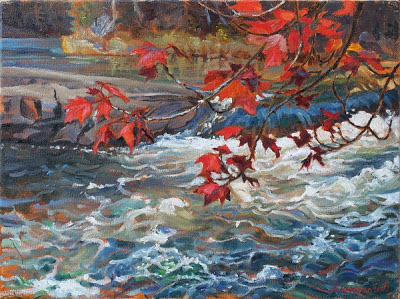Young Fir in the Old Cellar (oil on canvas 4 x 7 in.) Sold
3 July finds me sitting on the edge of an old cellar hole at what used to be a homesite on the Caledonia Mountain Road, north of Riverside-Albert, New Brunswick. This is a second-growth portion of the Caledonia Gorge Protected Natural Area, and as we first walked in from the road we waded through a shallow carpet carpet of Bunchberry in bloom, each plant with a single white dogwood flower. Soon the Bunchberry was mixed, and then replaced, by a lush ground cover of small, heart-shaped violet leaves. Fred noticed a long-stemmed Rhubarb plant and I said "look for where the house used to be!" Then we saw the cellar hole in a sea of violet leaves. Three walls of carefully stacked stones, with the fourth buried where the forest floor slopes in. Trees are growing against the cellar wall, spruce, fir, and Paper Birch, and a young Fir has established itself near the centre, where it poses for my painting.
I begin with a black underpainting, to represent the darkness of the cellar when it was still part of the house. I imagine the time when the light began to penetrate - perhaps when part of the floor caved in, allowing indirect light from a broken window to penetrate the darkness. Some time later, sky light would have reached the cellar floor through a gap in the roof. Now the only sign of the ruins of the house is the cellar hole, lined with mossy stones that hopeful human hands placed there over a hundred years ago - and in the centre of what used to be darkness, a young Fir tree waves its bright spring needles in the sunshine that dapples through the branches of older trees that stand inside the walls.
As I work, Fred circumnavigates the violet patch so in the future it will be possible to see if and how fast it's spreading. We will take a sample to the Bio-blitz botanists to see if they can be identified - though Fred couldn't find any with seed capsules, which violets bury in the ground for ants to disperse. These plants are hairier and paler than the European Viola odorata that's spreading behind our home in eastern Ontario. We wonder if the legacy of the cellar hole may be an invasive violet....
I begin with a black underpainting, to represent the darkness of the cellar when it was still part of the house. I imagine the time when the light began to penetrate - perhaps when part of the floor caved in, allowing indirect light from a broken window to penetrate the darkness. Some time later, sky light would have reached the cellar floor through a gap in the roof. Now the only sign of the ruins of the house is the cellar hole, lined with mossy stones that hopeful human hands placed there over a hundred years ago - and in the centre of what used to be darkness, a young Fir tree waves its bright spring needles in the sunshine that dapples through the branches of older trees that stand inside the walls.
The raucous voices of young Ravens rip the silence of the woods, screaming to each other about how bold and black they are, and we answer, imitating their falsetto screams. They fly low over the tree tops above us, answering us with more screams as if they think we are another Raven family - until an adult cruises over and comments "Graaawwwwk", turning away with a couple of youngsters following. That must be a Raven term in the local dialect for "humans".
As I work, Fred circumnavigates the violet patch so in the future it will be possible to see if and how fast it's spreading. We will take a sample to the Bio-blitz botanists to see if they can be identified - though Fred couldn't find any with seed capsules, which violets bury in the ground for ants to disperse. These plants are hairier and paler than the European Viola odorata that's spreading behind our home in eastern Ontario. We wonder if the legacy of the cellar hole may be an invasive violet....




the consensus on the identity of the Violets (Gart Bishop, Stephen Clayden, David Christie), obtained at the 5 July bioblitz open house, is the native 'Northern Woolly Blue' Viola sororia (formerly V. septentrionalis).
ReplyDeleteThis isn't the first time we've noticed a native plant making apparently unchecked vegetative progress through a forest - I guess it's a part of the process of reestablishing the forest flora in a second-growth woods. Which leads to the reflection that, even more than tree cover, the plants on the forest floor will never be in a static equilibrium, but will always be surging or receding as dispersal, light & water, fungal symbionts, and herbivores change conditions and competitive ability of the various species.